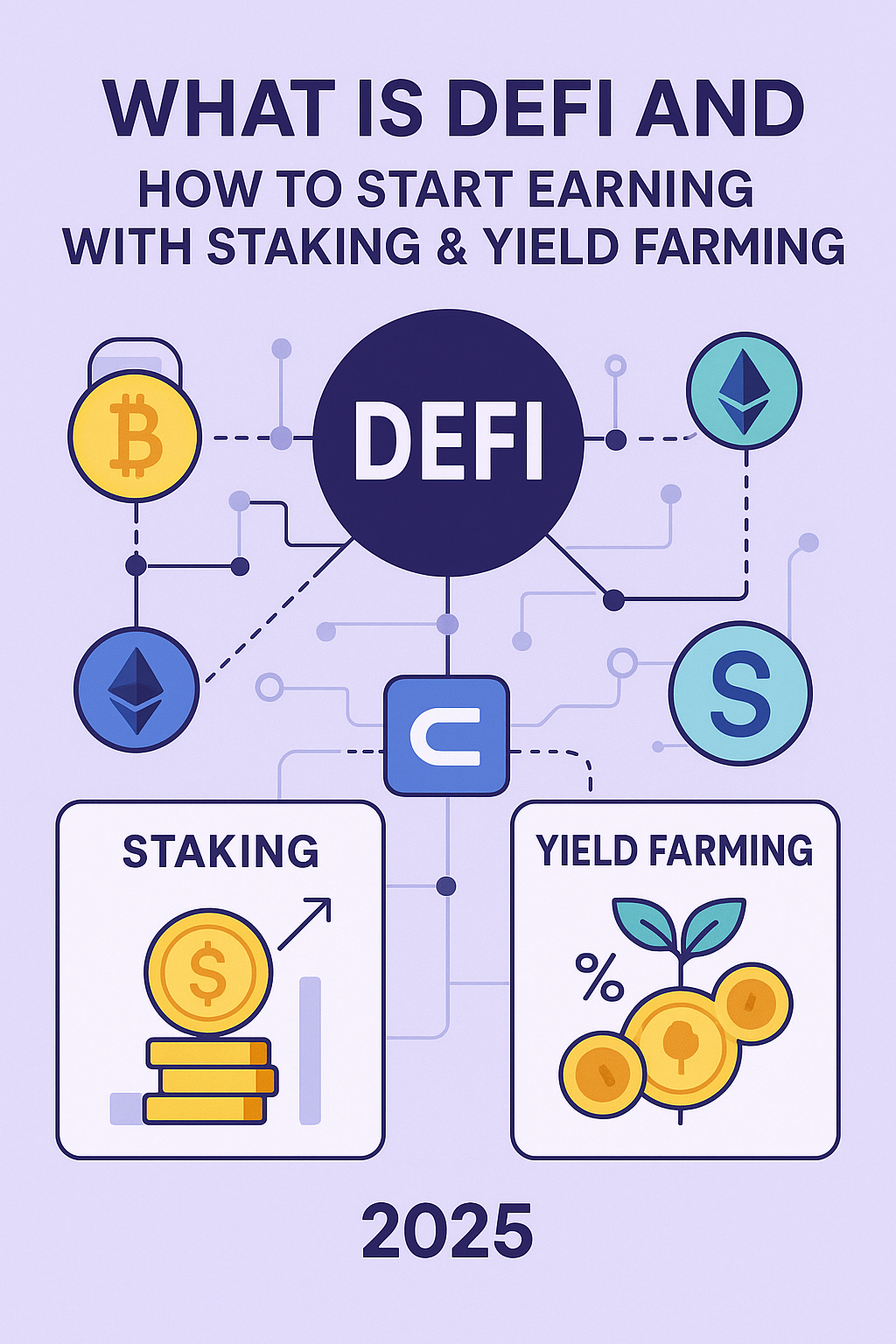🌐 What Is DeFi and How to Start Earning with Staking & Yield Farming
Decentralized Finance, or DeFi, has quickly become one of the most exciting areas in the crypto world. Instead of relying on banks or brokers, DeFi lets anyone with an internet connection access financial services — from lending and borrowing to trading and earning interest — all powered by blockchain technology.
In this guide, we’ll break down what DeFi is, how it works, and how you can start making money through staking and yield farming in 2025.

🚀 What Is DeFi?
DeFi stands for Decentralized Finance. Unlike traditional finance, which depends on centralized institutions (like banks or payment companies), DeFi uses smart contracts — programs that run on blockchains like Ethereum, Solana, or Binance Smart Chain.
With DeFi, you can:
Earn interest on your crypto
Trade tokens without an exchange
Take out loans without a bank
Participate in liquidity pools and governance
In short: DeFi gives you control of your money without intermediaries.
🔑 Why DeFi Matters in 2025
Global Access: Anyone can join, no matter where they live.
Transparency: Transactions are recorded on a public blockchain.
High Earning Potential: DeFi often offers higher yields compared to banks.
Innovation: Constantly evolving with new protocols, Layer 2 solutions, and cross-chain platforms.
📈 What Is Staking?
Staking means locking your cryptocurrency into a network to support its operations — like validating transactions. In return, you earn rewards, usually in the same token.
How It Works:
Buy a token that supports staking (like Ethereum, Solana, or Cardano).
Delegate or lock it in a staking pool.
Earn passive income as the network rewards you.
Example:
Ethereum (ETH) staking can earn 3–5% annually.
Polkadot (DOT) or Cardano (ADA) often offer higher rates (up to 10–12%).
🌾 What Is Yield Farming?
Yield farming is like advanced staking. Instead of just locking your tokens, you provide liquidity to DeFi protocols — like lending platforms or decentralized exchanges (DEXs). In return, you earn fees and additional rewards.
How It Works:
Deposit tokens into a liquidity pool (e.g., ETH + USDT on Uniswap).
Other users trade using that pool.
You earn a share of the trading fees + bonus rewards (in the protocol’s token).
Example:
Provide liquidity to Uniswap or PancakeSwap.
Earn fees + governance tokens (like UNI or CAKE).
Some pools in 2025 can still generate 10–50% APR, though rewards vary.
⚖️ Staking vs Yield Farming
Feature | Staking | Yield Farming |
|---|---|---|
Risk Level | Low–Medium | Medium–High |
Ease of Use | Simple | More complex |
Returns | 3–12% (average) | 10–50%+ (varies) |
Best For | Beginners, long-term holders | Active investors seeking higher returns |
⚠️ Risks to Know
DeFi is full of opportunities, but also risks. Before jumping in:
Smart contract risk – bugs or hacks can cause losses.
Impermanent loss – liquidity providers can lose value if token prices shift.
Scams & rug pulls – always research projects carefully.
Regulation changes – governments are paying closer attention to DeFi.
🛠️ How to Get Started in DeFi
Get a wallet (e.g., MetaMask or Trust Wallet).
Buy tokens from a reputable exchange.
Choose a DeFi platform (Uniswap, Aave, Lido, PancakeSwap).
Start small — stake or farm with a small amount first.
Diversify — don’t put everything into one protocol.
🎯 Conclusion
DeFi is rewriting the rules of global finance. Whether you’re looking for stable staking rewards or higher-yield opportunities through farming, there’s a strategy for every type of investor in 2025.
But remember: higher rewards come with higher risks. Always research before investing, and use a mix of staking and yield farming to balance your portfolio.
👉 Stay ahead of the curve with NFTBirdies Calendar — your hub for the latest NFT drops and Web3 trends.
Topics
Recent comments
